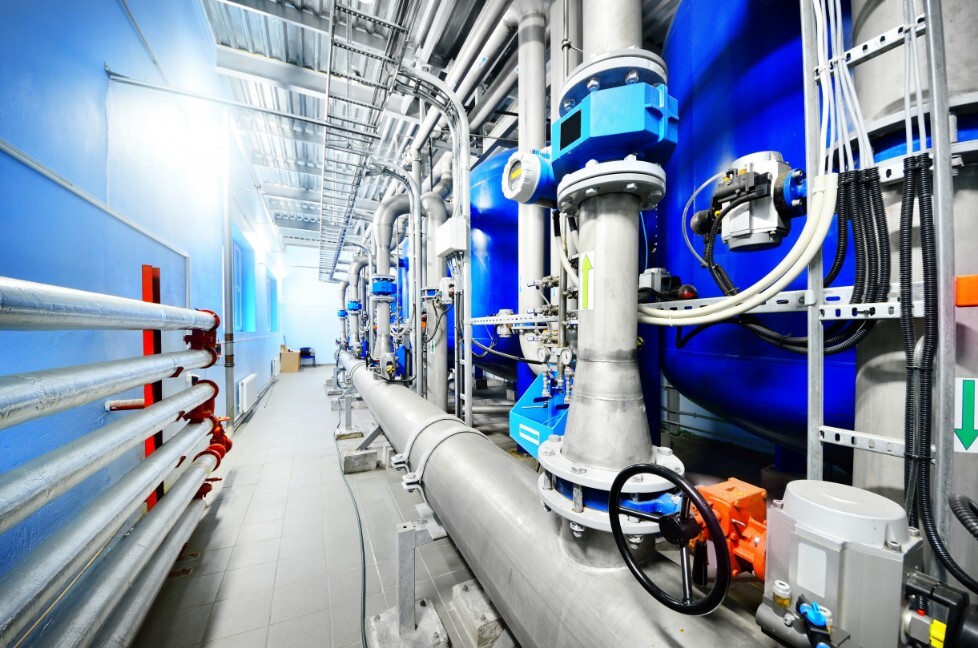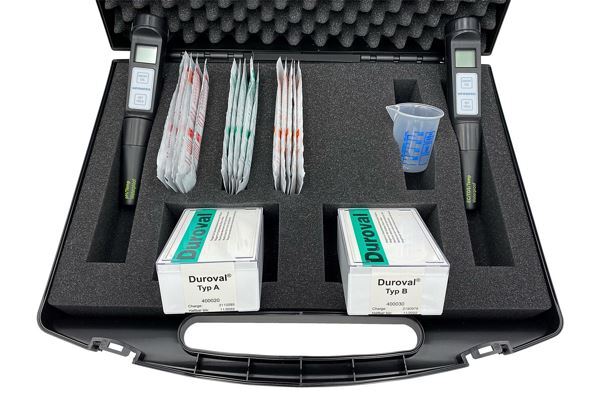Heating water treatment according to VDI 2035
Long-lasting heating systems without warranty risk through heating water treatment
Hot water heating systems are increasingly susceptible to damage due to the ingredients of the heating water, not least due to the further development of heating technology with highly efficient components. The previously common practice, for example, that water hardness or salt content in the heating water can be neglected because the water is in a closed circuit, has proven to be wrong, damage occurs continuously. Manufacturers of modern appliance technology now refuse warranty claims if the filling of the system does not comply with the state of the art (VDI 2035).

Heating water treatment for heating engineers
As a result, heating contractors must look more closely at the issue of heating water treatment, now also for smaller heating systems in homes. For each system, the water with which the heating system is filled must be checked, homeowners should definitely pay attention to this.
The technical standard is described in VDI 2035 “Prevention of damage in hot water heating systems”. In the event of damage, this VDI guideline is used as a basis for assessment. With the VDI 2035, plant engineers and operators of heating systems have an aid for avoiding damage (mostly corrosion) to their heating system and for preventing efficiency losses due to deposits on heat exchanger surfaces.
Mainly, the problems are caused by hardness constituents contained in the supply water with which the heating system is filled. Water hardness varies depending on the region. Permissible limits for the heating system filling water according to VDI 2035 are as follows:
| Heating capacity in kW | Water hardness for a boiler heating surface of 20 l/kW | Water hardness with boiler heating surface between 20 l/kW and 50 l/kW | Water hardness with boiler heating surface from 50 l/kW | |||
| mol/m3 | °dH | mol/m3 | °dH | mol/m3 | °dH | |
| Smaller than 50 | < 3 | ≤ 16,8 | 2 | ≤ 11,2 | 0,02 | < 0,11 |
| Between 50 and 200 | 2 | ≤ 11,2 | 1,5 | ≤ 8,4 | 0,02 | < 0,11 |
| Between 200 and 600 | 1,5 | ≤ 8,4 | 0,02 | < 0,11 | 0,02 | < 0,11 |
| From 600 | 0,02 | < 0,11 | 0,02 | < 0,11 | 0,02 | < 0,11 |
Hardness formers in water are mainly magnesium and calcium components, which get into the drinking water through simple dissolving processes (e.g. from gypsum) from nature.
These hardness formers are the cause of the so-called stone formation in heating systems.
This does not refer to stones in the conventional sense. It refers to the deposits that form when the aforementioned materials are dissolved out of the water and are deposited, for example, on the hot heat exchanger surfaces.
In addition to significant losses in efficiency*, this also leads to damage such as corrosion and stress cracking, and consequently to leakage. Pretreatment of the heating filling water is necessary in order to comply with the above-mentioned limits and to prevent such damage. Of course, the water hardness must be professionally determined and documented during this process.
*Example: a lime thickness of 1mm can worsen the efficiency of the heat exchanger by 10%, i.e. 10% increased energy consumption!
Other important parameters for the quality of the heating water are the pH value and the electrical conductivity. These are related to possible accelerated corrosion of metallic system parts and other unfavorable deposits in the system.
Permissible limit values according to VDI 2035 are as follows:
| Low salt operation |
Saline operation
|
|
| Electrical conductivity at 25 °C | < 100 μS/cm | 100 – 1.500 μS/cm |
| pH value at 25 °C | 8,2 – 10,0 | 8,2 – 10,0 |
| Oxygen | < 0,1 mg/l | < 0,02 mg/l |
Water-side corrosion in heating systems – necessary heating water treatment
In connection with pH value and conductivity, one speaks of water-side corrosion. Electrochemical processes, which depend on the interaction of the metallic materials of a heating system and on water quality and temperatures, can lead to the decomposition of metallic components. In addition to the problem of leaks, small particles released by the above processes in the heating system can be deposited at narrow points (fittings, heat exchangers, …) and thus significantly impair the function of the system.
Leakages or blockages at bottlenecks often lead to the failure of entire systems and result in considerable repair costs. Consequently, it is essential to professionally determine and document the pH value and conductivity of the heating water.
Another relevant parameter is the oxygen content, which increases corrosion. Oxygen is already present in tap water as a natural concentration.
As a rule, however, it is sufficient for new plants if the air in the system is completely removed, which is realized by automatic or manual deaerators.
In the case of old systems, usually with different expansion stages, it is often the case that the problem of oxygen diffusion cannot be controlled so easily. In this case, regular monitoring of the oxygen content is necessary with appropriate dosing of oxygen binding agents.
For the pre-treatment of the heating water (before or during the system filling) there are common processes like
- Softening
- Desalination
- pH value stabilization
all of which are offered by heating specialist companies at relatively low cost.
For example, softening systems based on the ion exchange principle are used, desalination is realized by means of mixed bed filters or osmosis systems. For pH stabilization and oxygen binding there are additives which are simply dosed into the heating system.
It is essential to monitor the pH value, firstly approx. 10 weeks after filling the system and later at longer intervals (e.g. for regular maintenance) to ensure an optimum permanent setting.
In general, the regular inspection and, if necessary, treatment of the heating water provides a solid security to operate heating systems efficiently and without damage for a long time.
In the meantime, manufacturers of modern heating devices refer to the mandatory compliance with VDI 2035 and the associated measures, not least against the background of the warranty.
Treatment of the heating water and the corresponding professional recording and documentation of the water parameters is therefore mandatory for every specialist company in order to avoid warranty risks. Ultimately, system operators and homeowners are also better protected as soon as the specifications of VDI 2035 are fully complied with.
Analysis case for heating water treatment
- Electronic conductivity meter with interchangeable probe for determination of conductivity in the range of 0-3999 μS/cm with a resolution of 1 μS/cm and the TDS- value in the range of 0-2000PPM with a resolution of 1 PPM. Automatic temperature compensation 0-60°C. IP65.
- Conductivity calibration solution EC 1413 μS/cm, +-1% @25°C, 5 bags a 20ml.
- Electronic pH meter with interchangeable probe for determination of pH value in the range of 0.0-14.0 with a resolution of 0.1 pH.
- Buffer solution pH 4.01, +-1% @25°C, 5 bags a 20ml
- Buffer solution pH 7.01, +-1% @25°C, 5 bags a 20ml
- Buffer solution pH 10.01, +-1% @25°C, 5 bags a 20ml
- Duroval A complete with measuring tube, indicator, dosing pipette calibrated 0-30 °dH and 50 ml titration solution for approx. 100 analyses with measuring time: approx. 2 minutes.
- Duroval B complete with measuring tube, indicator, dosing pipette calibrated 0-2 °dH and 50 ml titration solution for approx. 100 analyses with measuring time: approx. 2 minutes.
- Plastic case with foam insert
*Please note that we guarantee a minimum shelf life of 7 months.
VDI- Richtlinie 2035 – Vermeidung von Schäden in Warmwasser- Heizungsanlagen
Laut der VDI-Richtlinie 2035, Blatt 2, sollten Veränderungen des pH-Wertes oder zu hohe
elektrische Leitfähigkeit (LF) vermieden werden, um Korrosionsschäden an Heizungsanlagen vorzubeugen.
Anhand unserer mitgelieferten Lösungen, Indikatoren und Tester, kann eine optimale Kontrolle und Überwachung der relevanten Werte stattfinden. Die passenden Werte für Ihre Heizungsanlage, können Sie in der VDI- Richtlinie 2035 oder bei Ihrem zuständigen Heizungsinstallateur in Erfahrung bringen.
